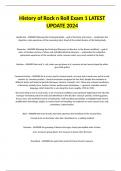Exam (elaborations)
History of Rock n Roll Exam 1 LATEST UPDATE 2024
- Course
- Institution
Apollonian - ANSWER following the Greek god Apollo -- god of harmony and reason -- emphasizes the objective, calm experience of the reasoning mind, freed of the violent desires of the feeling body Dionysian - ANSWER following the Greek god Dionysus (or Bacchus, in the Roman tradition) -- god of ...
[Show more]



